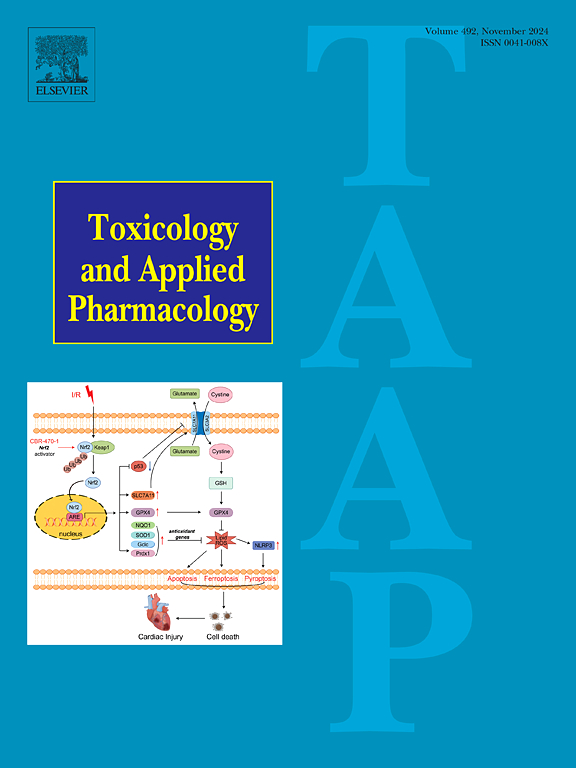Hinokitiol induces developmental and cardiovascular toxicity in zebrafish larvae and potential mechanisms
IF 3.3
3区 医学
Q2 PHARMACOLOGY & PHARMACY
引用次数: 0
Abstract
Hinokitiol is a natural compound collected from the trunk of cypress, belonging to the tropolone family of compounds. It has anti-inflammatory, anti-tumour and antibacterial activities, making it a natural product with a wide range of applications. It is used as an additive in hair growth agents, toothpaste, make-up and furniture wood. However, the toxicity of hinokitiol remains poorly understood. Therefore, the cardiovascular and developmental toxicity of hinokitiol in organisms was investigated in zebrafish larvae. In the study, zebrafish embryos were exposed to hinokitiol for 3 days to study the developmental and cardiovascular toxicity of hinokitiol. Concentrations for the hinokitiol toxicity test were set at 0, 0.4, 0.8, 1.2, 1.6, 2.0 and 2.2 mg/L. The experimental concentrations of 0, 0.8, 1.2 and 1.6 mg/L were subsequently determined based on phenotype. The results showed that exposure to hinokitiol resulted in increased mortality, changes in hatching rates and abnormalities in the apparent morphology of zebrafish embryos/larvae (shortened body length, reduced eye area, pericardial edema, and abnormal heart rate). In addition, hinokitiol impaired the cardiovascular system of zebrafish larvae, as evidenced by the absence of morphological features of the atria and ventricles, linearization of the heart, and reduction in the area and abundance of blood vessels. In addition, hinokitiol affects mitochondrial function by affecting iron ion levels and generates oxidative stress leading to apoptosis and which then generates cardiovascular toxicity. Our findings suggest that hinokitiol causes mitochondrial dysfunction and oxidative stress through iron chelation, which in turn triggers apoptosis, ultimately leading to cardiovascular and developmental toxicity in zebrafish larvae. The study provides new insights into the safety of hinokitiol and natural products.

扁柏醇诱导斑马鱼幼体发育和心血管毒性及其潜在机制
扁柏醇是一种从柏树树干中提取的天然化合物,属于tropolone族化合物。它具有抗炎,抗肿瘤和抗菌活性,使其成为具有广泛应用的天然产品。它被用作毛发生长剂、牙膏、化妆品和家具木材的添加剂。然而,对扁柏醇的毒性仍然知之甚少。因此,本研究在斑马鱼幼体中研究了扁柏酚对生物的心血管和发育毒性。本研究将斑马鱼胚胎暴露于桧木醇中3天,以研究桧木醇的发育毒性和心血管毒性。扁柏醇毒性试验浓度分别为0、0.4、0.8、1.2、1.6、2.0、2.2 mg/L。随后根据表型测定0、0.8、1.2和1.6 mg/L的实验浓度。结果表明,接触扁柏酚可导致斑马鱼胚胎/幼虫死亡率增加、孵化率改变和表观形态异常(体长缩短、眼面积缩小、心包水肿和心率异常)。此外,扁桃酚损害了斑马鱼幼虫的心血管系统,如心房和心室形态特征的缺失,心脏的线性化,血管的面积和丰度的减少。此外,扁柏醇通过影响铁离子水平影响线粒体功能,并产生氧化应激导致细胞凋亡,进而产生心血管毒性。我们的研究结果表明,扁柏酚通过铁螯合引起线粒体功能障碍和氧化应激,进而引发细胞凋亡,最终导致斑马鱼幼虫心血管和发育毒性。该研究为扁柏酚和天然产品的安全性提供了新的见解。
本文章由计算机程序翻译,如有差异,请以英文原文为准。
求助全文
约1分钟内获得全文
求助全文
来源期刊
CiteScore
6.80
自引率
2.60%
发文量
309
审稿时长
32 days
期刊介绍:
Toxicology and Applied Pharmacology publishes original scientific research of relevance to animals or humans pertaining to the action of chemicals, drugs, or chemically-defined natural products.
Regular articles address mechanistic approaches to physiological, pharmacologic, biochemical, cellular, or molecular understanding of toxicologic/pathologic lesions and to methods used to describe these responses. Safety Science articles address outstanding state-of-the-art preclinical and human translational characterization of drug and chemical safety employing cutting-edge science. Highly significant Regulatory Safety Science articles will also be considered in this category. Papers concerned with alternatives to the use of experimental animals are encouraged.
Short articles report on high impact studies of broad interest to readers of TAAP that would benefit from rapid publication. These articles should contain no more than a combined total of four figures and tables. Authors should include in their cover letter the justification for consideration of their manuscript as a short article.

 求助内容:
求助内容: 应助结果提醒方式:
应助结果提醒方式:


